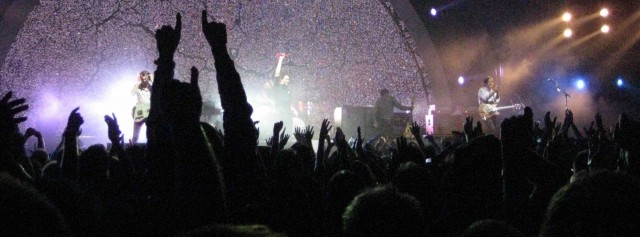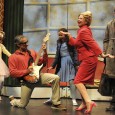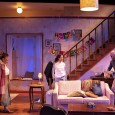The Sydney music community does exist. It may be quiet but there is a steady push of alternative music back into the mainstream, writes Elizabeth New.
If we believe recent portrayals in the media, Sydney’s music scene is in irretrievable ruins. The focus is always on venue closures, strict council regulations and the fickleness of fans.
But last year, the Australasian Performing Right Association (APRA) found that of the $1.21 billion pumped into the economy annually by 3901 live music venues across Australia, 32 per cent came from NSW. With only 22 per cent coming from Victoria, it would seem Sydney’s scene isn’t as weak as Melbournites would like to think. The only stickler is in recent venue closures.
“What Sydney’s lacking is 200-capacity venues,” says Dan Rule, owner/manager of the Annandale Hotel.
Strategic marketer Rebekah Lambert agrees, saying the successive closures of the Hopetoun, Excelsior and Tone hit the scene hard.
“When the Annandale looked like it was going to be sold, it started looking really grim,” she said.
Venues of this size are crucial for the growth of up and coming artists. Matt Dickinson of Sydney band The Upskirts points out the importance of popular venues.
“Punters are less willing to fork out cash for a single band, or a relatively unknown venue,” he said.
“Playing at a well established or well-known place is so vital to attracting a good crowd, and ultimately, creating a good vibe.
“You see more and more events such as ‘Hand Games @ Good God’, ‘MUM @ World Bar’ and ‘FBi Social @ Kings X Hotel’ that encourage punters who share similar tastes in music to not just see one band, but a host of bands”.
Such creative responses abound from musicians, businesses and punters alike. In a survey Lambert conducted in 2011, she found the scene was “a changing model”.
“It’s not without its issues but people who genuinely want music are finding ways to make it and enjoy it,” she said.
To keep its live music alive, the Annandale adopted a crowd-funding campaign which Lambert calls a “smart way to save their own bacon”.
The campaign received lots of support right across the music scene. It succeeded through what Rule terms “word of mouth marketing”, predominately through online media.
“The passion of the music community is evidence of Sydney’s thriving scene,” Rule said.
Digital and social media have unlocked such opportunities. According to Dickinson, support of the scene by local radio stations like FBi, 2SER and Triple J’s Unearthed is how Sydney music is “still achieving most of its vibe”.
Support accumulates online. Web communities flourish: collective passions culminate in reunion tours, indie and theme nights, and house or warehouse parties. The people have always been there but the internet’s accessibility has opened routes to bring together lovers of live music.
Businesses are capitalising on these interests, marketing a music community lifestyle as they create venues that amalgamate live music, food, cinema and market stalls. Sydney punters have money to spend and leisure time to fill.
I met with Colin Benge in his office in the Manning building at Sydney University, just underneath the bar he manages. The building was teeming with student life so the conversation was somewhat drowned out by background chatter.
Although Manning Bar differs in its business from other Sydney venues, (Benge estimates about half its revenue comes from students and half from music events), there is a move by venues across the city to multi-use. “You’ve got to have that adaptability for sure,” he says.
“Obviously, you’re not going to go to the Enmore when there’s nothing on,” Benge adds.
He observes the growth of multi-use venues in Sydney, noting that Manning couldn’t survive as either just a student or music venue.
Musicians agree.
“There is no denying how important it is to have live venues act as cultural centres in Sydney,” says Gus Gardiner, bass player in Sydney band Papa vs Pretty.
“Not just places where bands play and hone their craft but also places where the whole artistic community hangs out, people express themselves, meet other people and exchange ideas.”
More pubs are focusing on serving good food, hosting events and developing “accessibility for locals” within the lifestyle. Rule says this kind of thinking played a huge part in the ‘Buy a Brick’ campaign for the Annadale. By investing in the hotel, people were “joining a community”.
Charity events are also adding to the ‘community’ of the scene. On March 18, Melbourne institution the Reclink Community Cup made its debut in Marrickville. Although rain threatened all morning, the clouds cleared to perfect Sunday football weather. But the crowd certainly wasn’t an Aussie Rules crowd: beers were boutique, the oval-side stage was conspicuous and all profits went to charity. The musician-heavy crowd was obviously there for the community event and there were more laughs than ‘specky’ marks at Henson Park.
Monster Sessions t-shirts were everywhere on the day, and many people showed support for the annual Manning Bar concert that raises funds for Multiple Sclerosis research. Charity events are apparently popular with alternative music fans.
Benge has noticed the atmosphere at these events is particularly positive, with people mindful of the cause when they attend. Perhaps this explains the support for the Annandale’s fundraiser.
“Everyone feels some sort of association with the Annandale,” Benge admits.
As I write, across the city the scene builds its future. June 2012 will see the Rock n Roll Alternative Markets move to its new home at Sydney University’s Manning Bar, expanding to encompass three levels of specialty stalls and live music.
The local music economy grows. Reunion tour announcements are bringing older punters out of the shadows, and Spectrum introduces its new weekly punk night.
Lambert sums up Sydney’s current scene.
“We should support those who produce independently, and also those venues that maintain a live music culture,” she said. “Clever management, working together and choosing to think creatively to maintain the scene will help.”
This is where the scene becomes the community. And the community is going strong.




